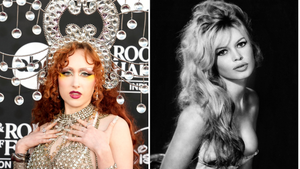Last year, close to 13 million people visited Berlin, twice the number of annual visitors recorded 10 years previously. The city is positively bursting at the seams. Not many years ago, a vast number of Berlin apartments stood empty; these days, a pervasive housing shortage threatens to get worse. Berlin is in. But Berlin is also a projection surface for dreams and desires, a promise of a different, freer, better life.
Now, this Berlin enthusiasm is nothing new. Close to a century ago - as the Weimar Republic was nearing its end - Berlin was already a vibrant metropolis the likes of which could not be found anywhere else in the world.
"The city looks to me like a scintillating gem," the American dancer and singer Josephine Baker observed. "These big coffee shops are like ocean steamers, and the orchestras are their machines that resound all over the place, keeping it in motion. The music is everywhere."
Visitors both German and foreign, such as the two English writers W.H. Auden and Christopher Isherwood, felt almost magically attracted by Berlin - by the city's great size, by its rhythm, but most of all by its gay scene. "Berlin," Auden remarked, "is a dream for pederasts." And Isherwood, years afterward, expressed the city's fascination most succinctly: "To Christopher," he wrote, "Berlin meant boys." Everything seemed possible; everything was possible.
As the capital city of the German Empire (the Second Reich, dissolved in 1919), Berlin was already the home of a multibranched, many-sided queer subculture. In the 1920s, Berlin could offer more than a hundred cafes, bars, and taverns that were mainly frequented by queer people of all stripes.
W.H. Auden and Christopher Isherwood treasured such taverns as the Cozy Corner, near the Hallesches Tor in the borough of Kreuzberg; in this homely little joint, Berlin's gay scene presented itself undisguised, and there were always half a dozen boys lounging around and drinking beer. Some establishments, such as the fabled Eldorado, on Motz Street in the borough of Schoneberg, even made it into the guidebooks.
The writer Emil Szittya remembered a visit to a transvestite bar named "Mikado": "At the piano sat the Herr Baron Sattlergrun, who however preferred to be called 'Baroness.'" Another legendary spot was Silhouette, a small, permanently smoke-filled pub that did a thriving business well into the wee hours of the morning. While the guests ate chicken soup, a pale young man, wearing woman's clothes and accompanied by a blind pianist, would sing melancholy songs; Marlene Dietrich and the composer Friedrich Hollaender were two of Silhouette's regular customers.
In the evening hours, certain parts of the Tiergarten (the large park in the middle of the city) were turned into gay playgrounds; moreover, there were veritable gay brothels, camouflaged as bathhouses or massage parlors, where men could meet and have sex.
Permissive and tolerant as the gay scene may have been, the relevant laws were neither. In the common perception of the time, "deviant sexual acts between men" were perverse, and in the eyes of the law, they were criminal. Paragraph 175 of the Reichsstrafgesetzbuch, the criminal code of the German Empire, made homosexual activity a punishable offense; transgressions could entail a penalty of up to six months in prison. However, the Berlin police and judicial authorities did not, as a rule, look too closely. A charge followed only "if the performance of the sexual act 'resembled heterosexual copulation,'" a criminal defense lawyer remembered. "Of course, only the other partner could testify to that. This absurd practice led, naturally, not to a reduction in the amount of sex being had, but to blackmail by street boys."
At the same time, though it was true that flamboyantly gay life, with its extravagances and its excesses, was indeed tolerated, it wasn't always legitimate. In fact, in the heady atmosphere of Paragraph 175, what flourished was criminality. Many a prominent gentleman on a trawl through Berlin nightlife fell into the hands of a blackmailer, who after the sex was over demanded hush money. Not a few paid out enormous sums over a period of many years, practically ruining themselves.
When the National Socialists seized power in January 1933, democracy came to an end in Germany. For queer people, the conditions of life rapidly worsened, especially after the following March, when the Reichstag enacted the so-called Enabling Act, the Ermachtigungsgesetz. With the passage of that law, the principle of separation of powers was abolished and the establishment of a totalitarian regime rendered possible. In 1935 the Nazis increased the severity of Paragraph 175 of the German criminal code, and in 1936 they created the Reich Central Office for Combating Homosexuality and Abortion. Antigay discrimination and a crackdown on sexual "deviance" were now national objectives.
Even leading figures of the day felt the effects of this new ethno-nationalistic Puritanism. In the summer of 1936, the famous gay actor Gustav Grundgens, fearing arrest, made a mad dash for Switzerland. The German regime, however, didn't want to do without Grundgens; the actor obtained sweeping security guarantees from Hermann Goring himself and soon returned to Berlin. Grundgens's colleague Kurt von Ruffin wasn't so lucky - in 1934-1935, because of his sexual orientation, he served a nine-month sentence in the Lichtenburg concentration camp in Saxony, where he endured horrific torture.
Things didn't go any better for the well-known songwriter and film music composer Bruno Balz, who was locked up in Plotzensee prison for eight months; after his release, Balz had to get married - to Selma, a blond peasant woman from Pomerania. And several thousand uncelebrated other gay people were carried off, mistreated, or murdered.
It was an unsettling concurrence: While gay life was dramatically changing, while pubs and bars were being forced to close and people were disappearing, Berliners and their guests were enjoying themselves quite splendidly. As cynical as it may sound, nightlife in Nazi Berlin carried on at a thoroughly international level. The starting point for nocturnal excursions was often Augsburger Street, which back then counted among Berlin's entertainment strips. At the intersection where Augsburger Street ended in Luther Street stood the Scala, the capital's most famous variety theater. Along with the always popular Scala girls, a group of 24 scantily clad female dancers, the bill featured a conspicuous number of American artists: the dancer Mathea Merryfield from California ("America's prettiest chorus girl"); the diminutive mime artist Fred Sanborn, who also played a mean saxophone; the Four Trojans, a quartet of acrobats performing dizzying tricks at dizzying heights; and Jack and George Dormonde, two slapstick artists on unicycles.
Diagonally opposite the Scala was the renowned Horcher restaurant. Anyone who wished to dine at the Horcher needed a well-stuffed wallet and a great deal of patience, for the small venue did excellent business and was as a rule fully booked. Celebrated actors numbered among the regular guests, as well as many politicians and diplomats. Hermann Goring showed up on a weekly basis. In the Horcher, one ate and spoke French. Otto Horcher - the maitre d'hotel - personally looked after each of his guests; he was acquainted with all his regulars' culinary preferences and understood how to satisfy them unobtrusively. Almost all the dishes were prepared at the dining tables. The Horcher's specialties included Medaillons Horcher and Faisan de Presse, whose preparation involved passing a pheasant's bones through a silver-plated press, thus producing an extremely rich and full-bodied sauce. All of the desserts - for the most part crepes, in every conceivable variation - were created and flambeed before the eyes of the diners.
Not far from Kurfurstendamm was the elegant Sherbini Bar. Berliners regarded this establishment, owned and operated by the Egyptian Mostafa El-Sherbini, as the capital's "Jazz Eldorado," the African-American trombonist Herb Flemming and his band played the Sherbini from 1935 to 1937.
Another Egyptian ran the Ciro Bar on Ranke Street. Achmed Mustafa offered his guests jazz music exclusively: "We could get away with a lot, because we had an international clientele, and that international clientele naturally attached great importance to hearing the same repertoire that they enjoyed in foreign countries," a contemporary witness recalled.

Above: Oliver Himes
Kurfursten Street also showed an international flair. The posh nightclub Quartier Latin belonged to a Romanian who placed a high value on exclusivity; only guests wearing tuxedos or evening dresses were allowed in. Admittedly, the Nazis who frequented the place remained unaware that the proprietor was, on top of everything else, a Jew.
Ernst "Teddy" Stauffer and his "Original Teddies" performed at the famous Delphi Palace on Kant Street. Stauffer played, almost without exception, an American repertoire, including the hottest swing music and Broadway tunes. "Practically the whole playlist comprised worldwide hits by successful Jewish writers, composers, and publishers," Teddy Stauffer wrote in his autobiography.
American swing music, "colored" jazz musicians, and French restaurants, along with Egyptian and Romanian entrepreneurs running exclusive bars where international businesspeople enjoyed themselves side-by-side with well-known Nazis - none of that seems to fit the commonly held image of Nazi Berlin.
My book Berlin 1936 proposes a portrait of a contradictory time, in which Adolf Hitler's popularity with the German people attained record heights while, simultaneously, 10,000 spectators in Berlin's Olympia Stadium cheered a black American, the exceptional athlete Jesse Owens. The book examines political, cultural, and everyday history, reassesses supposedly great and supposedly trivial events and circumstances, and discusses culprits and victims, heroes, passive followers, and careerists, courageous resisters, and silent rebels.
Translated by John Cullen
OLIVER HILMES is the author of Berlin 1936: Sixteen Days in August.





































































Charlie Kirk DID say stoning gay people was the 'perfect law' — and these other heinous quotes